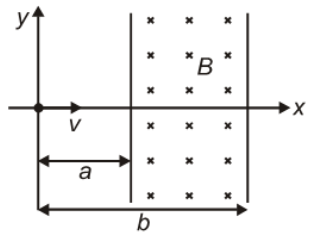When a proton is released from rest in a room, it starts with an initial acceleration towards the east. When it is projected towards the north with a speed , it moves with initial acceleration towards east. The electric and magnetic fields in the room are -
1.
2.
3.
4.
A positively charged particle descends vertically. In which direction will the horizontal component of the earth's magnetic field deflect?
1. east
2. west
3. north
4. south
The figure shows a particle of charge q and mass m moving with velocity v along the x-axis enters a region of the uniform magnetic field. The minimum value of v so that the charge q is deflected by an angle is

1.
2.
3.
4.
An electron is traveling along the x-direction. It encounters a magnetic field in the y-direction. Its subsequent motion will be:
1. Straight-line along the x-direction
2. A circle in the xz-plane
3. A circle in the yz-plane
4. A circle in the xy-plane
| 1. | \(B\) acts along the \(x\text-\)axis |
| 2. | \(B\) acts along the \(y\text-\)axis |
| 3. | \(B\) acts along the \(z\text-\)axis |
| 4. | \(B\) can act along any of the above direction for the net force to be zero |

1. \(0.25~\text{N-m}\)
2. \(5.2~\text{N-m}\)
3. \(2.5~\text{N-m}\)
4. \(0.52~\text{N-m}\)
A circular coil of wire of radius 'r' has 'n' turns and carries a current 'I'. The magnetic induction (B) at a point on the axis of the coil at a distance from its center is :
1.
2.
3.
4.
The dots in the figure depict a magnetic field that is perpendicular to the plane of the paper and emanates from it. The trajectory of a particle in the plane of the paper is depicted by the curve \(ABC\). What exactly is the particle?

| 1. | Proton. | 2. | Electron. |
| 3. | Neutron. | 4. | It cannot be predicted. |
| 1. | the speed will change. |
| 2. | the direction will change. |
| 3. | both (1) and (2) |
| 4. | none of the above |
The unit of reduction factor of the tangent galvanometer is
1. Ampere
2. Gauss
3. Radian
4. None of these
